To the unenlightened or unskilled PC consumer, technical nerd talk can be somewhat baffling and exasperating.
When looking at information, if it is full of so many terms as “port,” “TCP,” “UDP,” and different abbreviations or technical phrasing, the consumer feels more excluded and only once in a while finds a solution or insight.
Luckily, understanding is simply minutes away. This article will sync up on a port and simplify the technical terms as best as possible.
What is a port on a router and a switch
A port is a virtual point where network associations start and end. Ports are programming based and overseen by a PC’s working structure. Each port is related to a particular cycle or administration.

Image 1. A port is a point where network associations start and end
Ports permit PCs to skillfully separate between various traffic types: messages go to an unforeseen port instead of to pages, for example, even though both appear at a PC over a similar Internet connection.
What Is A Port Number?
A port number is the logical address of every application or sequence that utilizes a network or the internet to allow. A port number exceptionally distinguishes an application put together by a system concerning a PC.
For instance, all Hypertext Transfer Protocol (HTTP) messages go to port 80. While IP delivers approve statements to go to and from particular gadgets, port numbers authorize direct services or applications within those gadgets.
What Is TCP?
TCP represents Transmission Control Protocol, which relates to information transmissions on the internet.
TCP is extensively more reliable. It is an association-based transmission of information. There must be points between sending domain to receiving location. Information A, which was the first to be shipped, will always arrive before information B. The transmission that falls flat is one of the broken ones.

Image 2. TCP is one of the most reliable protocoles
For example, if the internet’s association for the sender’s website is down or a recipient’s site is down, an email address is not essential. The email operator is the receiving point that matters here—not the user name.
What IS UDP?
The User Datagram Protocol, or UDP, is a correspondence protocol utilized over the internet for particularly time-touchy communications, for example, video playback or DNS queries.
It speeds up exchanges by not officially building up an association before moving the information, which permits data to transfer rapidly. Yet, it can likewise make packages to become lost on the way — and push open doors for misuse as DDoS attacks.

Image 3. UTP is a correspondence protocol utilized for communications
Difference Between TCP And UDP
- Connectivity:TCP works when there is a connection between the sender and the receiver. But, UDP does not require that.
- Reliability:TCP is more reliable as it does not lose data during the transfer. Even if it does, it manages to fix it by itself. It also ensures that there is no misuse or hack. UDP, on the other hand, provides no guarantee and can be easily corrupted.
- Speed: TCP is slower because it performs more functions than UDP. UDP is a good option for when in a hurry.
- Ordering:UDP does not follow an order like TCP. TCP ensures that all its packages are ordered and sent accordingly.
Find Port Number
Windows:
- Start your Command Post.
- Type in the word’ ipconfig.’
- Then type in ‘netstat-a,’ and you will receive a list of multiple port numbers.
Mac:
- Start system preferences.
- Look for Network and then select Advanced.
- Choose the option labeled ‘Port Scan’ and enter the IP address whose port number you need.
Why Is Port Number Important?
Since the specific software may utilize various sorts of ports, examining your port numbers can help set up firewalls and give applications individual permissions.

Image 4. Examining the number of prts will help to set up firewalls and give applications individual permissions
It’s likewise understandable to see numerous ports at some random time for a similar application. VPNs, for example, are known to utilize multiple ports at the same time.
Which Ports Are Open By Default?
There are many ports. A port number can be anything from 0 to 65535! That doesn’t mean any application can pick any port. Set up standards and ranges are established, which encourages us to sort out the disorder.
While it’s difficult to list every vital port, these standard ports are valuable to know:
- 20 – FTP
- 22 – Secure Shell
- 25 – Simple Mail Transfer Protocol
- 53 – Domain Name System
- 80 – Hypertext Transfer Protocol
- 110 – Post Office Protocol
- 143 – Internet Message Access Protocol
- 443 – HTTP Secure
Since there are vast numbers of necessary port numbers, the least demanding methodology is remembering the ranges, which will let you know whether it is a reserved port or not.
Because of Google, you can likewise look into which administrations utilize a particular port instantly by a simple search.
In conclusion, port numbers are essential to be able to share data over the internet. It also makes sending and receiving incredibly comfortable and lets us enjoy the ease of data transfer like we do today.

